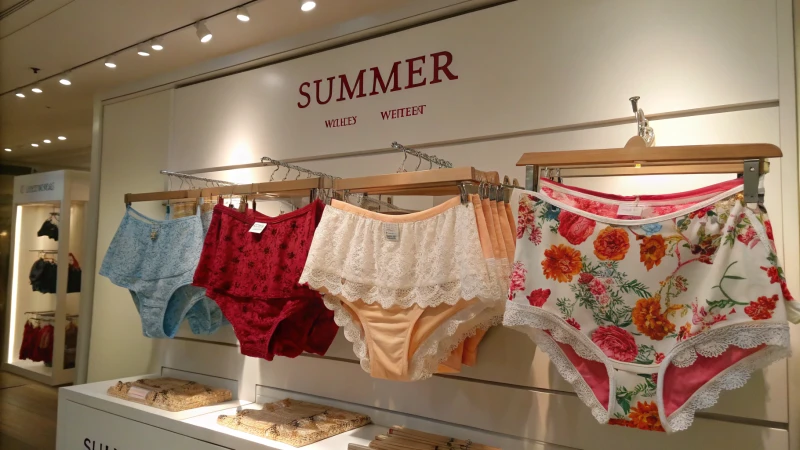
Ever wondered how to keep your custom underwear business thriving during peak seasons?
Effectively planning for seasonal demand means diving into past sales data, predicting trends, and working closely with manufacturers to tweak your orders based on expected changes. Flexibility in ordering and tight supplier relationships are key to balancing stock levels and satisfying customers.
I remember my first year in the custom underwear business, caught off guard by a winter rush. It was both exciting and overwhelming, teaching me valuable lessons about anticipating customer needs. To truly master this, you need more than just a grasp of the basics.
Let’s dive deeper into strategies that can refine your approach. By analyzing sales patterns from previous years—especially around holidays or seasonal shifts like summer and winter—and keeping an eye on emerging trends in colors and fabrics, you can better align your inventory with consumer desires. Partnering closely with manufacturers ensures you're ready for those higher volume periods, without overstocking or running short. This balance helps maintain operational efficiency and boosts customer satisfaction, making the seasonal shifts work in your favor.
Analyzing historical sales data helps forecast seasonal demand.True
Historical data provides insights into past trends, aiding in prediction.
Ignoring supplier collaboration leads to better stock management.False
Supplier collaboration is crucial for adjusting orders to demand changes.
What Factors Shape Seasonal Demand in Custom Underwear?
Have you ever wondered why your favorite underwear styles seem to change with the seasons?
Seasonal demand for custom underwear is shaped by shifts in consumer preferences, emerging market trends, and production hurdles. By understanding these factors, businesses can tailor their products to meet the evolving demands of each season effectively.

Consumer Preferences and Seasonality
I've always been fascinated by how my clothing choices shift with the weather. In summer, I gravitate towards lightweight and breathable fabrics like cotton or bamboo—perfect for those sweltering days. Conversely, winter has me reaching for warmer materials like wool blends or fleece. This personal experience mirrors broader consumer behavior, where preferences for custom underwear change with the seasons.
| Season | Preferred Fabrics | Color Trends |
|---|---|---|
| Summer | Cotton, Bamboo | Bright Colors |
| Winter | Wool Blends, Fleece | Darker Tones |
Even color trends aren't immune to seasonal shifts. I notice my wardrobe brightening in the warmer months, only to darken as temperatures drop. These changes also play out in the custom underwear market. Add gender-specific preferences into the mix—like how my male friends often prioritize functionality while I might seek trendy styles—and you've got a dynamic demand landscape tailored to fashion trends1.
Market Trends Influencing Demand
One summer, I remember scrolling through social media and seeing everyone rave about a celebrity-endorsed underwear line. It was wild how quickly that style became a must-have! Market trends like these—driven by celebrity endorsements, fashion week highlights, and social media buzz—can dramatically influence seasonal demand.
For instance, if a star showcases a unique style at a summer festival, people flock to buy similar designs. There's also a growing trend toward eco-friendly materials, especially during Earth Day campaigns. Staying on top of these trends helps businesses align their offerings with what people are clamoring for.
Production and Supply Chain Challenges
I've learned the hard way that planning is key, especially when it comes to managing stock levels. The excitement of a new season can quickly turn into panic if supply doesn't meet demand. Production challenges like lead times and minimum order quantities (MOQ) adjustments are critical to addressing seasonal needs.
By collaborating closely with manufacturers, businesses can streamline production schedules and avoid issues like overstock or shortages. Flexible ordering options are invaluable for responding swiftly to changing demands, ensuring that customers receive their purchases on time without disruption2.
Think about big promotional events or holidays like Christmas and Valentine's Day—they require meticulous advance planning. Analyzing historical sales data aids in forecasting demand accurately, enabling businesses to optimize production and inventory levels.
In essence, by delving deep into these factors, businesses can craft strategies that not only meet seasonal demand but also elevate customer satisfaction by delivering precisely what people want when they want it.
Bright colors are preferred for winter underwear.False
Bright colors are preferred in summer; darker tones are favored in winter.
Eco-friendly materials spike during Earth Day promotions.True
Eco-friendly materials gain popularity due to increased awareness during Earth Day.
How Can Historical Sales Data Improve Your Demand Forecasting?
Have you ever felt like you're playing a guessing game with your inventory? Dive into how historical sales data can change that.
Historical sales data is like a crystal ball for demand forecasting, revealing trends, patterns, and anomalies in consumer behavior. By analyzing this data, businesses can make informed decisions about future inventory needs, ultimately improving efficiency and reducing costs.

Unveiling Trends Through Historical Data
I remember the first time I stumbled upon the power of historical sales data—it was like finding a map in the middle of a maze. By diving into past numbers, I began to see patterns I hadn't noticed before. For example, there was this one winter where sales spiked by 15%. At first, it was a surprise, but then I realized it coincided with an increase in promotions and festive marketing. Once I started tracking these trends, my approach to inventory planning transformed. I could anticipate busy seasons and prepare, which saved me from the chaos of overstock or worse, running out when demand was high.
| Year | Season | Sales Increase (%) |
|---|---|---|
| 2020 | Winter | 15 |
Understanding Patterns and Anomalies
Have you ever noticed a sudden spike in demand and wondered why? Once, we had an unexpected surge that caught us off guard. At first, we thought it was a fluke, but a deeper dive into our historical sales data revealed it was tied to a viral social media campaign. By recognizing these anomalies—such as unexpected spikes or drops—I learned to adapt strategies quickly; it's like having a secret weapon in your business toolkit.
Integrating Market Trends
But here's the thing—historical sales data isn't just about the past; it's about seeing the future. When you combine it with current market trends3, it paints a fuller picture. I started noticing how certain colors or fabrics became popular, and by aligning our offerings accordingly, we stayed ahead of competitors. It’s like knowing what’s cool before everyone else does.
Collaborating with Manufacturers
I've found that sharing insights from my sales forecasts with manufacturers is crucial. Imagine you're working with a trusted partner who knows your needs inside out—that's the kind of relationship I strive for. By preparing them for anticipated changes4 in demand, we ensure smooth operations without hiccups. This collaboration means shorter lead times and fewer bottlenecks.
Flexibility in Ordering and Stock Management
One of my favorite strategies is adopting flexible ordering options based on insights from historical data. This approach has allowed me to adjust Minimum Order Quantities (MOQs) according to projected demand—helping manage both surplus and shortages effectively so that optimal stock levels are maintained throughout the year. This flexibility has been pivotal in ensuring we meet customer needs without compromising quality or delivery timelines.
Historical sales data identifies consumer trends.True
Analyzing past sales data reveals patterns and trends in consumer behavior.
Ignoring market trends enhances demand forecasting.False
Market trends, combined with historical data, improve demand forecasting accuracy.
How Can I Build Stronger Relationships with Manufacturers?
Ever felt like your partnerships with manufacturers could use a little extra magic? Here's how to make those connections truly thrive.
To really amp up collaboration with manufacturers, focus on crystal-clear communication, align your goals, and nurture those relationships like they're your best friends. Regular feedback and embracing technology can also pave the way to a flourishing partnership.

Establishing Clear Communication Channels
Effective communication is the foundation of successful collaboration. I remember a time when a simple miscommunication led to a production delay that could have been easily avoided. That's why I can't stress enough the importance of establishing clear communication channels. Consider implementing regular meetings, both virtual and in-person, to discuss ongoing projects and address any concerns. Utilize project management tools like Trello5 or Slack to facilitate real-time updates and information sharing.
| Communication Tool | Purpose |
|---|---|
| Trello | Task Management |
| Slack | Instant Messaging |
Aligning Goals and Expectations
Aligning goals with your manufacturer is like being on a tandem bike—both need to pedal in sync for smooth sailing. Aligning your company's objectives with the manufacturer's goals ensures everyone is working towards the same outcomes. This includes setting clear quality standards and delivery timelines. Establish key performance indicators (KPIs) as guideposts to measure success and identify areas for improvement.
- Quality Standards: Define acceptable levels for product specifications.
- Delivery Timelines: Agree on realistic deadlines.
Investing in Relationship-Building Activities
There's something about breaking bread together that builds trust and camaraderie. Long-term relationships are built on trust and mutual respect. Engage in activities that foster these values, such as factory visits, joint workshops, or team-building events. By understanding each other's cultures and operations, you can anticipate potential challenges before they become roadblocks.
Implementing Feedback Loops
Feedback isn't just about critique; it's about growth. Regularly solicit input from manufacturers on how processes can be optimized. Similarly, provide constructive feedback on their performance to encourage mutual growth6. It's a two-way street that keeps the partnership dynamic.
Leveraging Technological Integration
Technology can be daunting, but integrating solutions like ERP systems has transformed how I manage operations. Integrate technological solutions like ERP systems to streamline operations and improve data accuracy. These systems can automate inventory management and order processing, reducing the chances of errors while ensuring accuracy and efficiency without the constant worry of human error.
| Technology | Benefit |
|---|---|
| ERP Systems | Streamline Operations |
| Automated Tools | Reduce Human Error |
By embracing these strategies, I've seen partnerships blossom into efficient, innovative collaborations that drive business success. Incorporating these strategies can help develop a strong partnership with manufacturers, ultimately leading to improved efficiency and innovation. Tailoring these approaches based on your specific industry needs can lead to optimal results—so go ahead and dive into these strategies; your manufacturing relationships will thank you!
Regular meetings improve manufacturer collaboration.True
Regular meetings facilitate better communication and address concerns promptly.
Ignoring feedback loops enhances manufacturer relationships.False
Feedback loops are crucial for identifying areas of improvement and growth.
How Do Flexible Ordering Options Benefit Your Inventory Management?
Ever felt like your inventory management was a never-ending juggling act? Flexible ordering options could be your game-changer.
Flexible ordering options let me tweak order quantities based on demand, helping me dodge both overstock and stockouts. This flexibility means I can sync up my inventory with real-time needs, cutting down on waste and optimizing storage.

Enhancing Efficiency and Cost Reduction
I've discovered that flexible ordering options can seriously streamline inventory processes. By adjusting order quantities to mirror demand fluctuations, I can keep those pesky inventory holding costs7 in check. This strategy not only slashes the risk of overstocking but also frees up capital from being tied up in surplus inventory.
Real-time Demand Alignment
These flexible ordering options are my secret weapon for aligning inventory with real-time demand. They're especially handy during peak seasons or when market changes catch me by surprise. For example, during a recent sales promotion at my retail store8, I was able to ramp up orders for popular items, ensuring I met customer demands without any hiccups.
| Benefit | Description |
|---|---|
| Cost Efficiency | Reduces unnecessary storage costs and financial waste. |
| Demand Responsiveness | Quick adaptation to changing market needs. |
Adapting to Market Trends
Another huge perk is the ability to pivot quickly with market trends. As consumer tastes shift, I can tweak my stock levels accordingly. Take, for instance, when a hot new seasonal trend hit the scene, my clothing store was able to boost orders to match the latest fashion preferences9, keeping us ahead of the curve.
Collaborating with Suppliers
Building strong supplier relationships has been key to maximizing flexible ordering benefits. By negotiating terms that allow adjustments in minimum order quantities (MOQ), I gain more control over inventory levels. This collaboration often leads to better terms and a more efficient supply chain.
Balancing Supply and Demand
Flexible ordering options help me strike the perfect balance between supply and demand, crucial for maintaining optimal stock levels. By keeping an eye on sales patterns and leveraging data analytics, I can forecast more accurately and place orders that reflect actual needs.
| Strategy | Outcome |
|---|---|
| Data Analysis | Informed decision-making based on sales trends. |
| Supplier Flexibility | Enhanced negotiation power and adaptable MOQs. |
With the help of advanced inventory management systems10, I'm better equipped to respond swiftly to market changes, ensuring I stay competitive while delighting my customers.
Flexible ordering reduces inventory holding costs.True
By matching order quantities to demand, businesses minimize storage costs.
Real-time demand alignment increases stockouts.False
Aligning inventory with real-time demand reduces the risk of stockouts.
Conclusion
To effectively plan for seasonal demand in custom underwear, analyze past sales data, collaborate with manufacturers, and utilize flexible ordering to align inventory with consumer preferences.
Discover upcoming fashion trends that can influence women's underwear choices for the summer season. ↩
Learn effective strategies to optimize lead times in your supply chain, ensuring smooth production and inventory management. ↩
Exploring market trends enables businesses to align products with current preferences, improving demand prediction accuracy. ↩
Collaborating with manufacturers on anticipated changes ensures supply chain readiness, preventing stockouts or excess inventory. ↩
Learn how Trello can streamline task management and improve team collaboration. ↩
Discover strategies for fostering growth through effective feedback and collaboration. ↩
This link provides strategies to minimize inventory holding costs, improving financial efficiency. ↩
Learn how retail stores adjust inventories during sales events to meet customer demand. ↩
Stay updated on the latest fashion trends and align your inventory with consumer demands. ↩
Discover top inventory management systems that enhance adaptability and efficiency. ↩






